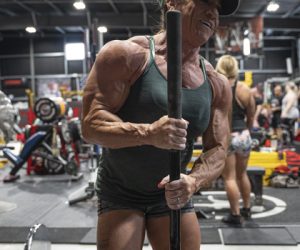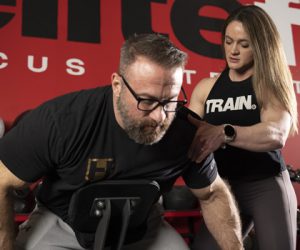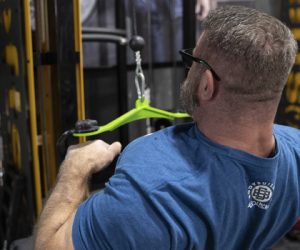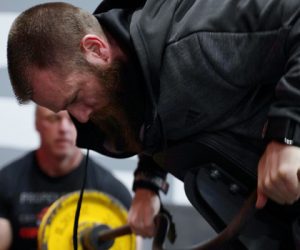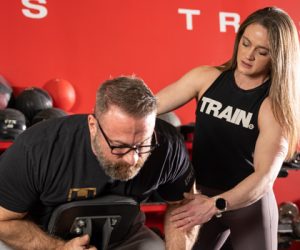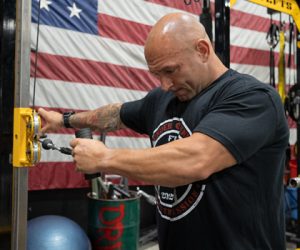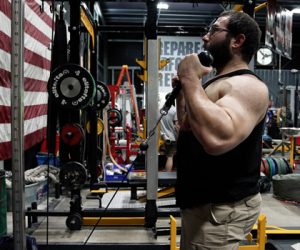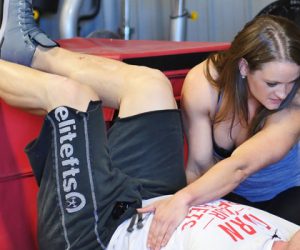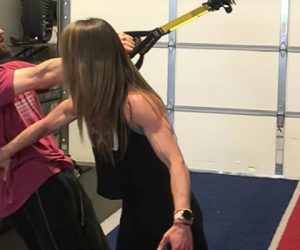How to Progress Anti-Tin Man RDLs
One way to progress the Anti-Tin Man RDL is by taking that same pattern into a more dynamic and less stable environment through Walking RDLs.
Revisiting the Cross-Body Cable Extension
The Cross-Body Cable Extension has enormous potential to address a myriad of shoulder and upper back issues, but you’re doing it wrong.
Intensity Techniques to Use in a Rehab Block
Ditch the boring “three sets of eight to ten reps of rehab movement,” to break the mold and bridge the gap between training and rehab.
Feel Your Back Again with the Seated Prone Row Bench
The most underrated benefit to this setup is allowing the thoracic spine and ribcage position to be easily manipulated. Hello, rear delts and lats!
#91 - All Things Nutrition and Training with Justin Harris and Dani LaMa...
Justin Harris and Dani LaMartina are guests on this episode of Dave Tate’s Table Talk to discuss training, recovery, and diet in lifting.
I Am Dani LaMartina
Who’s Dani? Where is she from? What are her passions? What is she accomplishing in her practice and lifting career? She tells you here.
Train and Rehab with Crossbody Extensions
Crossbody extensions address tissue tolerance and scapular awareness—something to use for direct upper body training AND physical therapy.
Blending Training and Rehab for the Powerbuilder
There’s no reason to be sidelined into rehab purgatory when dealing with a combination labral tear with bicep tendinopathy. Read how this case study is applicable to you.
The Beauty of Quiet Technique
If you’re looking to be strong, improve durability, and look better, quiet technique will get you there with less wear and tear. Here are implications and executions of this technique using a variety of exercises.
My Left Glute is Not Activating
Anyone who’s actually said this and FELT this lack of power knows how frustrating it can be: Despite the EBP nerds saying, “Well, the hip is extending, so the glute must be firing.” If you have felt the empty feeling, you know that you’re not firing on all cylinders.
Tendinopathy Edition: Programming Variables to Consider When Returning t...
When it comes to returning an intermediate-advanced lifter to a heavy compound, there are often more factors at play than we initially think. Perfect mechanics probably aren’t enough to get you back to where you need to be.
The Most Underrated Exercise You’re Not Doing for Shoulder Health
Do your shoulders hurt at the bottom of the bench? If so, what are you doing to fix it? This exercise may help.
Control What You Can
I’m hoping that by the time this article gets published, things are on their way back to normal, but in the meantime (and even if they are), there are a few key tools I’ve given my clients to help them to mentally move forward (not just survive) when we feel a lack of control.
Top 6 Mistakes Powerlifters Make Health-Wise
I see the same mistakes made over and over, and these mistakes are absolutely huge when it comes to being able to keep training progressively.
Structuring a Rehabilitation Plan
Physical rehabilitation is as much about the mind as it is the body. The right attitude is the first step to putting a stable, consistent rehabilitation plan in motion.
Programming Through Injury: Good, Better, and Best Options
Programming through injury doesn’t need to be nearly as complicated as we make it. It’s not really all that different than programming a regular training block for a movement with a few differences.
Don't Ignore Systemic Interplay
If we want to help people, we have got to stop picking camps and start putting the client first. Here’s a prime example of how to do that with a focus on the respiratory system.
The Most Underutilized Kettlebell Exercise You Should Be Doing
We think of the Kettlebell Windmill as a largely upper body exercise, but I’d like to make a case that it’s one of the most underutilized exercises to promote hip loading and control bilaterally.
Romanian Deadlifts Revisited: How to Appropriately Apply The Hinge
There’s an assumption (known or unknown) that everyone has the proficiency to perform what we see “if we just lower the weight.” That’s quite the caveat with a lot of assumption, especially when it comes to movements like the Romanian Deadlift.
Understanding Groin Injuries: Complex Groin Injuries
When a doctor who knows how I train gave me his diagnosis, I had no idea what to do because I hadn’t met anyone that had this constellation of stuff. Neither had he. The best foundation we came up with was based on the same principles in the previous articles.
Understanding Groin Injuries: Tendon Injuries
Tendon injuries suck. The healing process for tendon injuries is slower than it is for muscle tears. If you ended up rupturing your tendon, you may require surgery. But there are still some things you can do in terms of rehabbing certain tendon injuries…
Understanding Groin Injuries: A Muscle Tear
The biggest thing you need to take away from muscle tears is that the healing process is largely chemically based and physiologically mediated in order to remedy the mechanical disruption and restore (again) mechanical strength.
Understanding Groin Injuries: A Primer
I’m not going to lie, I’ve had a number of injuries through my training, but Dave was right: groin injuries are a different beast, and the nature of the beast is going to depend more fully on what actual tissue was affected.
Keyboard Warriors Need to Stop!
People with similar issues can respond differently to the same treatments, so having multiple solutions is a great way to increase the likelihood of success. As for arguing about different solutions with experts on the internet? Not so great.
How Irradiation Can Be Detrimental
Even though Instagram makes neural irradiation look cool, please take a moment to stop and ask yourself: What is it, and why are you doing it?
A Basic Lifting Skill Review: Grip Strength
Every seasoned lifter appreciates how easy it is to lose simple habits in pursuit of getting stronger. One such habit: Getting a good grip.
The Intent of Recovery
Intelligent training does NOT need to be pussyfooting around HARD training. It also doesn’t need to be pushing you to a point where you have to “deserve” a rest day. Attending SWIS 2018 and listening to Dr. John Rusin and Christian Thibedeau, I thought it would be great to revisit this topic.
The Value of Accessory Work
I’m as guilty as anyone when it comes to moving a weight that makes me “feel good” about training, versus doing a movement that requires less weight on the bar because it exposes weakness.
Movement Patterns Beyond One Plane
If you’re looking a little shifty, if you’re feeling aches and pains on your competition movements, if you want a longer shelf life, if you want to feel athletic instead of “locked in” all of the time, finish your sessions with this. I promise you’ll move and feel better.
The Best Advice I Can Give to Future Physical Therapists
If you want to make a career out of working with strength athletes, there’s one thing that’s more important than everything else.
The Second Phase of Injury: Changing the Plan
I needed to know I wasn’t going crazy for wanting to know where things were scarring down, and I needed to know what to expect based on the injury itself. So I broke the mold a bit.
The Acute Phase of Injury: What Just Happened?
Once you’ve started the waiting game and it has sunk in you’re out of training for a while, there are definite ways to set yourself up for success. This is something I’m currently experiencing myself after tearing the adductor longus tendon from my pelvis.









